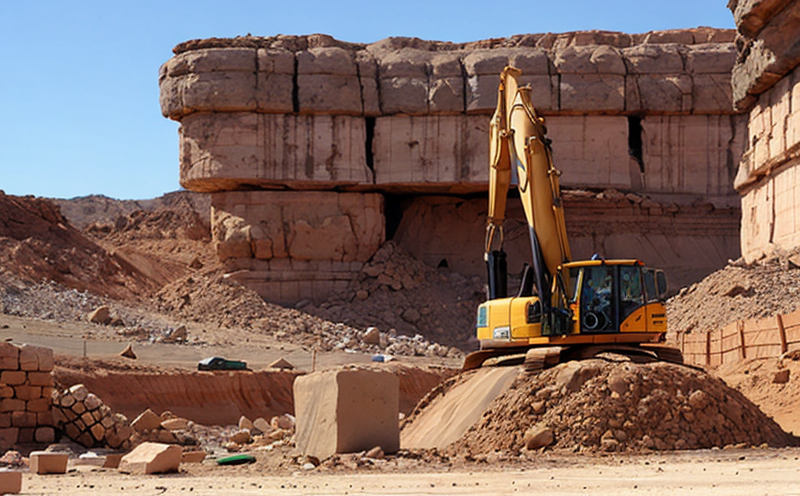ASTM D5607 Direct Shear Strength of Rock Joints Testing
The ASTM D5607 test method is a critical tool in geotechnical and mining engineering for assessing the direct shear strength of rock joints. This testing procedure measures the frictional resistance between two surfaces when subjected to shearing forces, providing essential data on the stability and integrity of rock formations.
Rock joints are natural or artificial discontinuities that can significantly influence the mechanical behavior of rocks under various stress conditions. Understanding these properties is crucial for predicting the structural performance of underground mines, tunnels, dams, and other geotechnical projects. The ASTM D5607 test helps in characterizing rock joint surfaces to ensure safe design and construction practices.
The testing process involves preparing a specimen with a specific geometry that mimics natural conditions as closely as possible. The shear strength is determined by applying incremental loads until the sample fails, allowing engineers to quantify the resistance of the joint. This information is vital for designing structures capable of withstanding expected stresses without failure.
The ASTM D5607 test can be conducted under different loading rates and environmental conditions, enabling researchers to study the influence of various factors on shear behavior. For instance, temperature variations or moisture content can affect the frictional properties, making this test particularly valuable in diverse geological environments.
Specimen preparation is a meticulous process that requires precise cutting techniques to ensure accurate representation of natural rock joints. Specialized tools and diamond saws are often used to achieve the necessary precision. Once prepared, specimens undergo conditioning to simulate the actual in situ conditions they will encounter during service life.
In instrumentation, strain gages play a crucial role by providing real-time monitoring of deformation within the specimen. This data helps in understanding how the joint behaves under different loading scenarios, contributing valuable insights for optimizing design parameters and enhancing safety margins.
Reporting from ASTM D5607 testing includes detailed descriptions of the test setup, procedures followed, and results obtained. Engineers analyze these data to interpret shear strength values which are then used in comprehensive analyses, such as finite element modeling or slope stability evaluations.
The significance of this test cannot be overstated for industries reliant on rock mechanics principles. Mining operations, in particular, benefit greatly from ASTM D5607 results since they directly inform critical decisions regarding excavation methods, support systems installation, and overall mine planning.
By adhering to the strict protocols outlined by ASTM D5607, laboratories can ensure that their findings are both reliable and reproducible. This standardization facilitates better communication among stakeholders involved in complex geological projects worldwide.
Why It Matters
The direct shear strength of rock joints is a fundamental parameter influencing the stability of various infrastructure types, including underground mines and tunnels. Accurate determination of this property ensures safer operations by preventing potential failures that could lead to catastrophic accidents.
In mining environments, understanding rock joint behavior under different loading conditions helps minimize risks associated with tunnel collapses or slope instabilities. Proper application of ASTM D5607 allows engineers to make informed choices about excavation techniques and support measures needed for safe extraction processes.
Moreover, the results from these tests contribute significantly towards sustainable practices by aiding in more efficient utilization of natural resources without compromising safety standards. By leveraging accurate data obtained through rigorous testing protocols like ASTM D5607, organizations can reduce waste while ensuring compliance with local and international regulations governing environmental impact assessments.
The importance of reliable testing methods cannot be overstated when dealing with high-risk applications such as mining. It is essential to employ techniques that provide consistent results across multiple trials so that decision-makers have confidence in their choices based on scientifically validated data.
International Acceptance and Recognition
The ASTM D5607 test method enjoys widespread international recognition due to its rigorous standards and consistent results. It has been adopted by numerous countries around the world as a benchmark for evaluating rock joint shear strength.
In Europe, several nations including Germany, France, and Spain utilize ASTM D5607 in their national codes of practice related to geotechnical engineering projects involving rock masses. Similarly, Asia Pacific regions like Australia and New Zealand also incorporate this testing procedure into their standards for assessing the mechanical properties of rocks used in civil engineering applications.
North America continues to see increasing adoption of ASTM D5607 within both academia and industry sectors throughout Canada and United States alike. International organizations such as ISO (International Organization for Standardization) recognize ASTM D5607 as an authoritative source for determining rock joint shear strength, further cementing its position in global standards.
By adhering to internationally recognized testing methods like ASTM D5607, laboratories demonstrate their commitment to quality assurance and compliance with best practices. This recognition enhances credibility among clients globally who require reliable data from independent third-party labs.
Environmental and Sustainability Contributions
Testing rock joint shear strength according to ASTM D5607 plays a vital role in promoting sustainable practices within the mining sector. By accurately assessing the mechanical properties of rocks, this testing method helps minimize environmental impacts associated with extraction activities.
One key contribution lies in optimizing excavation techniques by ensuring that only necessary amounts of material are removed from the site. This approach reduces unnecessary disturbance to surrounding ecosystems and preserves valuable resources for future generations.
Additionally, accurate assessment of rock joint shear strength allows for better planning of support systems designed to protect workers and equipment during mining operations. Properly engineered supports reduce the likelihood of accidents caused by structural failures, thereby enhancing occupational safety standards across industries.
The use of ASTM D5607 also contributes positively towards reducing waste generation in mining operations. With precise knowledge about how rocks behave under different loading conditions, companies can implement recycling programs aimed at reusing secondary materials rather than discarding them as waste products.
By integrating sustainable practices into their operational processes through rigorous testing procedures like ASTM D5607, organizations demonstrate leadership in environmental stewardship. This commitment not only benefits the immediate project but also sets a positive example for others to follow.





